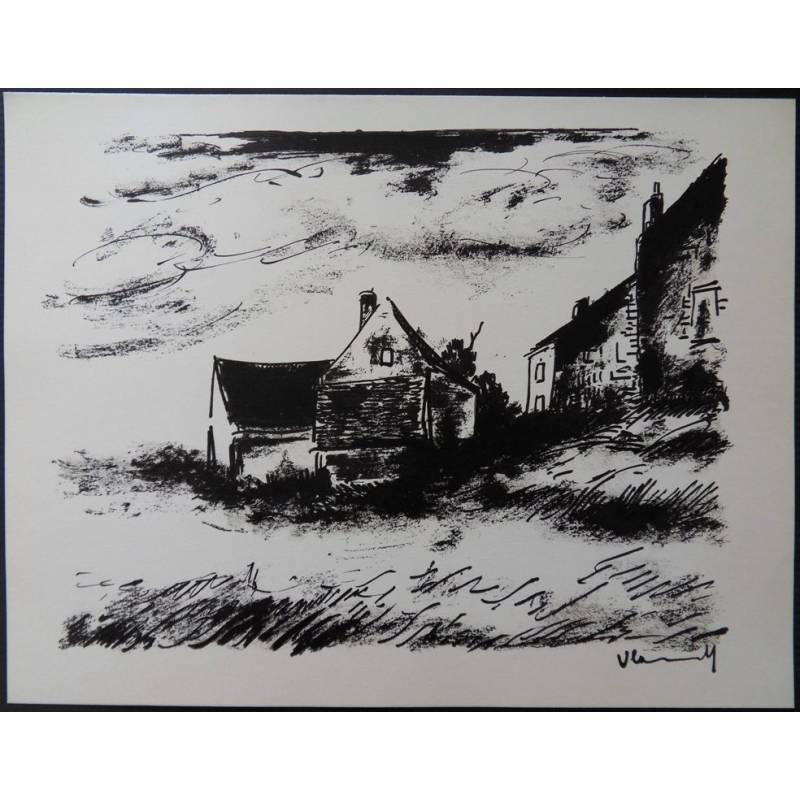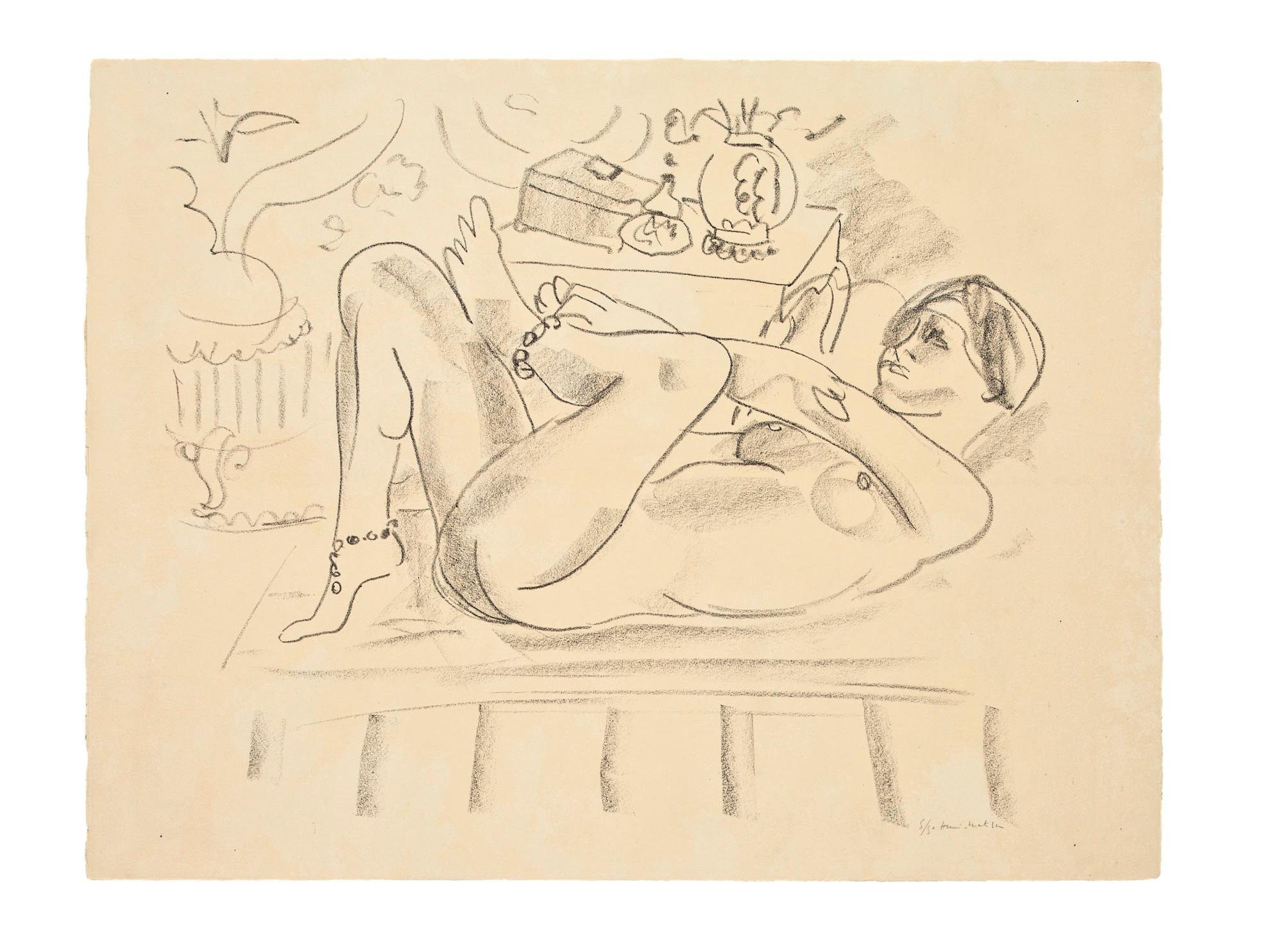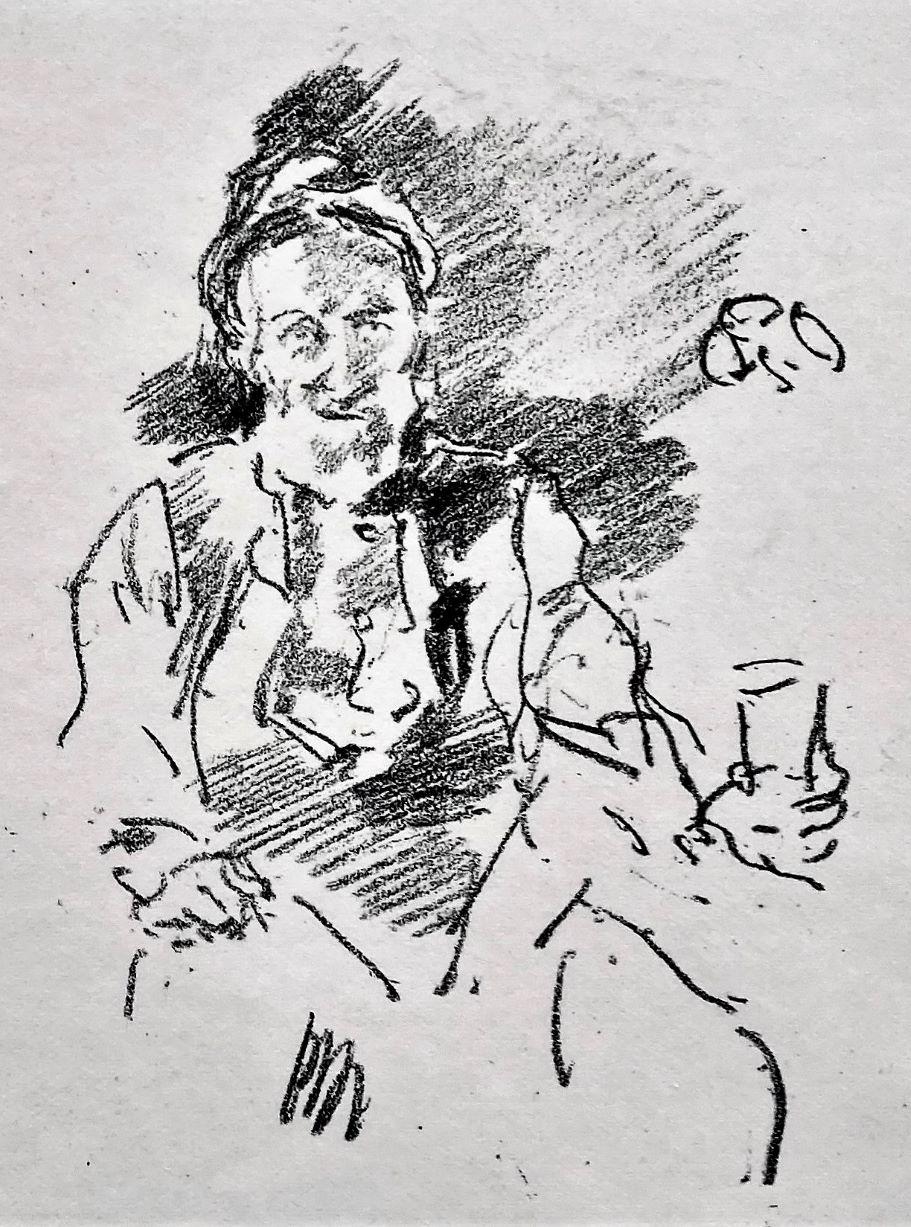Camille PissarroBûcheronnes - Groupe de paysannes by Camille Pissarro - Lithograph
About the Item
- Creator:Camille Pissarro (1831-1903, French)
- Dimensions:Height: 5.32 in (13.5 cm)Width: 9.53 in (24.2 cm)
- Medium:
- Movement & Style:
- Period:
- Condition:
- Gallery Location:London, GB
- Reference Number:1stDibs: LU261214155072
Camille Pissarro
Camille Pissarro was one of the most influential members of the French Impressionist movement and the only artist to participate in all eight Impressionist exhibitions.
Born in July of 1830 on the island of Saint Thomas in the Danish West Indies, Camille was the son of Frédéric and Rachel Pissarro. At the age of 12, he went to school in Paris, where he displayed a penchant for drawing. He returned again to Paris in 1855, having convinced his parents to allow him to pursue a career as an artist rather than work in the family import/export business. Camille studied at the Académie Suisse alongside Claude Monet, and, during this time, he met Paul Cézanne, Édouard Manet and Pierre-Auguste Renoir.
In 1869, Camille settled in Louveciennes. The outbreak of the Franco-Prussian War in 1870 prompted him to move to England, and, with Monet, Camille painted a series of landscapes around Norwood and Crystal Palace, while studying English landscape painting in the museums. Upon returning a year later at the end of the War to Louveciennes, Camille discovered that only 40 of his 1,500 paintings — almost 20 years’ work — remained undamaged.
Camille settled in Pontoise in the summer of 1871, remaining there and gathering a close circle of friends around him for the next 10 years. He reestablished relationships with Cézanne, Manet, Monet, Renoir and Edgar Degas, expressing his desire to create an alternative to the Salon, so that their group could display their own unique styles. Camille married Julie Vellay, with whom he would have seven children. Cézanne repeatedly came to stay with them, and, under Camille’s influence, he learned to study nature more patiently, even copying one of Camille’s landscapes in order to learn his teacher’s technique.
The first Impressionist group exhibition, initiated by Monet in 1874, earned the Impressionists much criticism for their art. While mainly interested in landscape, Camille introduced people — generally, peasants going about their rural occupations — and animals into his works, and they often became the focal point of the composition. It was this unsentimental and realistic approach, with the complete absence of any pretense, which seemed to stop his work from finding appreciation in the general public.
One of the few collectors who did show interest in Camille’s work was a bank employee named Paul Gauguin, who, after acquiring a small collection of Impressionist works, turned to Camille for advice on becoming a painter himself. For several years, Gauguin closely followed his mentor, and, although their friendship was fraught with disagreement and misunderstandings, Gauguin still wrote shortly before Camille’s death in 1906: “He was one of my masters, and I do not deny him.”
In the 1880s, Camille moved from Pontoise to nearby Osny, before Eragny, a small village much further from Paris. At a time when he was dissatisfied with his work, in 1885, Camille met both Paul Signac and Georges Seurat. He was fascinated by their efforts to replace the intuitive perceptive approach of the Impressionists with a “Divisionist” method, or scientific study of nature’s phenomena based on optical laws. Despite having reached his mid-50s, Camille did not hesitate to follow the two young innovators. The following year, he passed on this new concept to Vincent Van Gogh, who had just arrived in Paris and was keen to learn of the most recent developments in art. However, after a few years, Camille felt restricted by Seurat’s theories and returned to his more spontaneous technique while retaining the lightness and purity of color acquired during his Divisionist phase.
In the last years of his life, Camille divided his time between Paris, Rouen, Le Havre and Eragny, painting several series of different aspects of these cities, with varying light and weather effects. Many of these paintings are considered among his best and make for an apt finale to his long and prodigious career.
When Camille Pissarro died in the autumn of 1903, he had finally started to gain public recognition. Today his work can be found in many of the most important museums and collections throughout the world.
Find original Camille Pissarro art on 1stDibs.
(Biography provided by Stern Pissarro Gallery)
- ShippingRetrieving quote...Ships From: London, United Kingdom
- Return PolicyA return for this item may be initiated within 7 days of delivery.
- The Four Seasons - Spring by Lélia Pissarro, SerigraphBy Lelia PissarroLocated in London, GBThe Four Seasons - Spring by Lélia Pissarro (B. 1963) Serigraph 50.5 x 69 cm (19 ⅞ x 27 ⅛ inches) 61.5 x 79 cm (24 ½ x 31 ⅛ inches) Signed and numbered Printed in an edition of 300 ...Category
1990s Impressionist More Prints
MaterialsSilk, Lithograph
- The Four Seasons - Autumn by Lélia Pissarro, SerigraphBy Lelia PissarroLocated in London, GBThe Four Seasons - Autumn by Lélia Pissarro (B. 1963) Serigraph 51 x 69 cm (19 ⅞ x 27 ⅛ inches) 61.5 x 79 cm (24 ¼ x 31⅛ inches) Signed and numbered Printed in an edition of 300 Art...Category
21st Century and Contemporary Impressionist More Prints
MaterialsSilk, Lithograph
- Mère et enfant by Lélia Pissarro - EtchingBy Lelia PissarroLocated in London, GBMère et enfant by Lélia Pissarro (b. 1963) Etching 3 x 3 cm (1 ¹/₈ x 1 ¹/₈ inches) Signed lower left, Lélia Pissarro Inscribed lower right: E.A (artist proof in French) Artist biog...Category
21st Century and Contemporary Impressionist Figurative Prints
MaterialsEtching
- Paysanne au puits by Camille Pissarro - EtchingBy Camille PissarroLocated in London, GBPaysanne au puits by Camille Pissarro (1830-1903) Etching 23 x 19.3 cm (9 x 7 ⁵/₈ inches) Stamped lower left, C.P. and numbered 8/50 Created in 1891 and printed at a later date as a...Category
1890s Impressionist Figurative Prints
MaterialsEtching
- Une Femme Assise by Lucien Pissarro - EtchingBy Lucien PissarroLocated in London, GBUne Femme Assise by Lucien Pissarro (1863-1944) Etching 23 x 13 cm (9 x 5 ¹/₈ inches) Stamped lower right, L.P. and numbered lower left, 10/20 Provenance: John Bensusan Butt Private...Category
1890s Impressionist Figurative Prints
MaterialsEtching
- Prairies de Bazincourt by Camille Pissarro - Landscape etchingBy Camille PissarroLocated in London, GBPrairies de Bazincourt by Camille Pissarro (1830-1903) Etching and aquatint 8.1 x 12 cm (3 ¹/₄ x 4 ³/₄ inches) Stamped with initials lower left, C.P. and numbered 3/18 lower right T...Category
1880s Impressionist Figurative Prints
MaterialsEtching
- Maurice de Vlaminck - House in Rueil - Original LithographBy Maurice de VlaminckLocated in Collonge Bellerive, Geneve, CHMaurice de Vlaminck Original Lithograph Signed in the plate 1958 Title: House in Beauce Dimensions: 22 x 27 cm Reference: Catalogue raisonné Walterskirchen 275 Condition : Excellent Maurice de Vlaminck (1876 - 1958) Maurice was three years old when his family moved from Paris to Vésinet. He first pursued the same musical career as his parents, who were both musicians, leaving his home as a trained double-bass player in 1892 to move to Chatou near Versailles. After absolving his military service in Vitré Maurice Vlaminck worked as a musician until he accidentally met André Derain in 1900. It was Derain who kindled Vlaminck's artistic ambitions. He decided to become a painter and rented an old hut in which he and Derain shared a studio. A crucial turning point in Vlaminck's artistic development was a visit to a van Gogh exhibition...Category
1950s Impressionist Landscape Prints
MaterialsLithograph
- Nu, odalisque au coffretBy Henri MatisseLocated in London, GBLithograph on Arches Velin paper, Edition of 50 Paper size: 50.6 x 66 cms (19 7/8 x 26 ins) Image size: 45.4 x 54 cms (17 7/8 x 21 1/4 ins)Category
1920s Impressionist Figurative Prints
MaterialsLithograph
- MARC CHAGALL "Le joueur de flûte"By Marc ChagallLocated in Los Angeles, CAMARC CHAGALL 1887 - 1985 "Le joueur de flûte" 1958 Colour lithograph 25.5x44 cm, illustration; 38.3x57.3 cm, sheet size Signed lower right by the artist in ink "Marc Chagall" and dedicated "Pour Ursula et Gerd Hatje / "merci" / Marc Chagall / 1958". Inscribed lower left by the artist "Epreuve d'artiste". This is an artist’s proof, aside from the edition of 90. Catalogue Raisonné : Mourlot 197 Gerd Hatje (14 April 1915 – 24 July 2007) was a German publisher. The publishing house that he founded in 1945, named the Humanitas Verlag, renamed in 1947 as Verlag Gerd Hatje, is internationally known for contemporary art, photography and architecture. It merged in to Hatje Cantz in 1999. In the 1950s and 1960s, Hatje changed the focus to art, photography, and architecture.[1] He had contact with and was a friend of contemporary artists such as Hans Arp, Willi Baumeister, Joseph Beuys, Max Bill, Georges Braque, Marcel Breuer, Marc Chagall, Christo, Le Corbusier, Max Ernst, Alberto Giacometti, Walter Gropius, Joan Miró, Pablo Picasso, Ludwig Mies van der Rohe, and James Stirling...Category
Mid-19th Century Impressionist Figurative Prints
MaterialsLithograph, Paper
- New York : Break in Central Park - Original handsigned lithographBy Harold AltmanLocated in Paris, FRHarold ALTMAN New York : Break in Central Park MEDIUM : Stone lithograph SIGNATURE : Handsigned LIMITED : Artist Proof PAPER : Arches vellum SIZE : 56 x 76 cm (c. 22 x 30 in) INFORM...Category
Late 20th Century American Impressionist Figurative Prints
MaterialsLithograph
- Rue FurstenbergBy James Abbott McNeill WhistlerLocated in Storrs, CTRue Furstenberg. 1894. Lithograph. Way 59; Levy 90; Tedeschi, Stratis and Spink catalog 97. Only state. 8 7/8 x 6 1/4 (sheet 14 1/4 x 8 7/8). A fine ...Category
Late 19th Century Impressionist Figurative Prints
MaterialsLithograph
- The Master SmithBy James Abbott McNeill WhistlerLocated in Storrs, CT
The Master Smith. 1895. Lithograph. Way 84; Levy 123; Tedeschi, Stratis and Spink 120.i/ii. 4 1/2 x 5 1/2 (sheet 76 x 5 3/8). Only 15 lifetime impressions (in 2 states) were listed by Way; Goulding printed 38 impressions on 14 December 1903. The stone was erased in 1903. Printed on cream wove proofing paper. Monogrammed with the butterfly in the stone. A fine impression of this extremely rare lithograph.
Tedeschi, Stratis, and Spink write, page 366: As originally transferred to stone, the image includes trial marks made with a pointed crayon to the left of the sitter's shoulder. There is also a smudge at lower right below the image and a small stry mark upper right. Only one impression of this state has been located. Now in the Britigh Museum, London, it once belonged to Thomas Way and is illustrated in the Levy (1975) catalogue.' The impression illustrated above lacks the stray mark on the right, as the sheet is too small to accommodate it.
Tedeschi, Stratis and Spink write, page 366: 'This portrait of George Govier, was drawn ad the master smith conversed with the artist during a break from his work. Govier was born in Lyme Regis...
CategoryLate 19th Century Impressionist Figurative Prints
MaterialsLithograph



